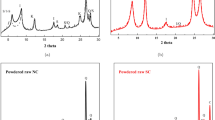Abstract
Transformation of clay minerals (smectite-zeolite, illite, kaolinite, and bentonite) and admixtures of iron oxides (hydroxides) under the action of an alkaline cyanobacterial community was studied. The results demonstrate that the processes of transformation of clay minerals such as intensification of removal of exchange bases and dissolution of silicates and iron oxides occurred in the presence of the alkaliphilic cyanobacterial community. The main factor that determines resistance of a mineral to biochemical weathering is its composition. Transformations of clay minerals in the course of active cyanobacterial photosynthesis (up to 14 days) and at decomposition of organic matter (OM) (28–60 days) are different. For smectite-zeolite and illite, these processes are dissolution of silicates and oxides (removal of Si and Fe) and removal of exchange bases (K), which were observed at both the of biomass production and OM destruction stages. For two other clays, the processes of neosynthesis are more typical: formation of carbonates (most probably siderite for bentonite clay and Mg-calcite for kaolin clay) and transformation of ferrihydrite into the more thermodynamically stable goethite.
Similar content being viewed by others
References
Stucki, J.W., Structural Iron in Smectites, in Iron in Soils and Clay Minerals, Stucki J.W., Goodman, B.A., and Schwertmann, U, Eds., NATO ASI Series, 1988, vol. 217, pp. 625–676.
Rozanov, A.Yu., Fossil Bacteria, Sedimentogenesis, and the Early Biospheric Evolution, Paleontol. Zh., 2003, vol. 39, no. 6, pp. 41–49 [Paleontol. J. (Engl. Transl.), vol. 39, no. 6, pp. 600–609].
Sokolova, T.A., Dronova, T.Ya., and Tolpeshta, I.I., Glinistye mineraly v pochvakh (Clay Minerals in Soils), Tula: Grif i K, 2005.
Naimark, E.B., Eroshchev-Shak, V.A., Chizhikova, N.P., and Kompantseva, E.N., Interaction of Clay Minerals with Microorganisms: Review of Experimental Data, Zh. Obsch. Biol., 2009, vol. 70, no. 2, pp. 155–167.
Gerasimenko, L.M., Nekrasova, V.K., Orleanskii, V.K., Venetskaya, S.Ya., and Zavarzin, G.A., Primary Production of Halophilic Cyanobacterial Communities, Mikrobiologiya, 1989, vol. 58, no. 3, pp. 507–514.
Trebst, A., Inhibitors in Electron Flow: Tools for the Functional and Structural Localization of Carriers and Energy Conversation Sites, Meth. Enzymol., 1980, vol. 69, pp. 675–715.
Arinushkina, E.V., Rukovodstvo po khimicheskomu analizu pochv (Manual on Chemical Analysis of Soils), Moscow: Mosk. Gos. Univ., 1970.
Alekseev, A.O., Alekseeva, T.V., and Makher, B.A., Magnetic Properties and Mineralogy of Iron Compounds in Steppe Soils, Pochvovedenie, 2003, vol. 36, no. 1, pp. 62–74 [Eur. Soil Sci. (Engl. Transl.), vol. 36, no. 1, pp. 59–70].
Walden, J., Oldfield, F., and Smith, J., Environmental Magnetism. A Practical Guide. Technical Guide no. 6, London: Quaternary Research Association, 1999.
Ransom, B., Bennet, R.H., Baerwald, R., Hulbert, M.H., and Burkett, P.-J., In situ Conditions and Interactions between Microbes and Minerals in Fine-Grained Marine Sediments: A TEM Microfabric Perspective, American Mineralogist, 1999, vol. 84, pp. 183–192.
Lowenstam, H.A. and Weiner, Sh., On the Biomineralization, New York: Oxford Univ. Press, 1989.
Pannalal, S.J., Crowe, S.A., Cioppa, M.T., Symons, D.T.A., Sturm, A., and Fowle, D.A., Room-Temperature Magnetic Properties of Ferrihydrite: A Potential Magnetic Remanence Carrier, Earth and Planetary Science Letters, 2005, vol. 236, pp. 856–870.
Zavarzina, D.G., Alekssev, A.O., and Alekseeva, T.V., The Role of Iron-Reducing Bacteria in the Formation of Magnetic Properties of Steppe Soils, Pochvovedenie, 2003, vol. 36, no. 10, pp. 1218–1227 [Eur. Soil Sci. (Engl. Transl.), vol. 36, no. 10, pp. 1085–1094].
Author information
Authors and Affiliations
Corresponding author
Additional information
Original Russian Text © T.V. Alekseeva, E.V. Sapova, L.M. Gerasimenko, A.O. Alekseev, 2009, published in Mikrobiologiya, 2009, Vol. 78, No. 6, pp. 816–825.
Rights and permissions
About this article
Cite this article
Alekseeva, T.V., Sapova, E.V., Gerasimenko, L.M. et al. Transformation of clay minerals caused by an alkaliphilic cyanobacterial community. Microbiology 78, 776–784 (2009). https://doi.org/10.1134/S0026261709060150
Received:
Published:
Issue Date:
DOI: https://doi.org/10.1134/S0026261709060150




